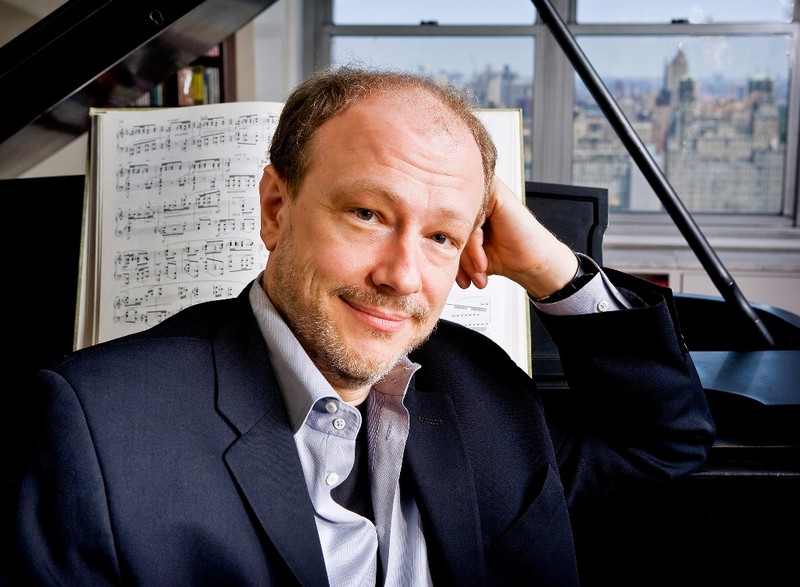Hamelin provides the highlight in mixed Philharmonic program

Sir Andrew Davis conducted the U.S. premiere of Julian Anderson’s “The Discovery of Heaven” Thursday night with the New York Philharmonic.
Why is it that orchestras composed of the world’s finest musicians can so often turn in performances that are beneath their abilities? Led by Sir Andrew Davis, the New York Philharmonic on Thursday played an intriguing program with the level of technical expertise that is to be expected of them, but too often without any apparent engagement with the music.
A U.S. premiere, Julian Anderson’s The Discovery of Heaven is a journey through a variety of soundscapes. The British composer commands a wide and impressive musical vocabulary, which is displayed in “An Echo from Heaven,” the first of the work’s three parts. Bright and harmonically spacious at its opening, it travels through sections made claustrophobic by closer dissonances and the independent and seemingly random free bowing of the violins. (Though not a novel gesture, it is employed here with more care and to greater effect than is often the case.) Counted silences are frequent, and seem not the slightest bit out of place.
“In the Street” sets lilting, silly woodwind melodies over the bustle of the rest of the orchestra. Anderson’s notes on the piece suggest that the listener meets an array of characters in this second part, and indeed these snatches seem to present a vibrant cast of personalities.
In the final section, “Hymns,” Anderson writes vast, stately music punctuated by irreverent outbursts of percussion. These persist and their spirit seems to take over for a time, recalling with frenzy the opening music before the percussion falls off entirely and serenity is restored. Of the work’s three parts, this last was the most effective. For all their harmonic fascination and variety of sound, the first two were lacking in emotive power, and “In the Street” had no sense of rushing pace or size, making the hum of the city seem just a generic business.
It may be, though, that the performance, and not the piece, was to blame. For the entire concert, Davis and the Philharmonic seemed detached, playing with technical and dynamic precision, but also a sort of complacency that kept the energy of the music low. This was made all the more glaring by their juxtaposition to the sensitive playing of Marc-André Hamelin.
In Franck’s Variations symphoniques for piano and orchestra, Hamelin exhibited spectacular touch, crisp but blooming, tossing off glittering flourishes with ease as well as care. His softer playing was tender, and his phrasing was made supple by tasteful rubato. Hamelin was alive and responsive to the playing of the orchestra, which too often failed to reflect his phrasing in return.
Such apparent disinterest did not bode well for Prokofiev’s Romeo and Juliet, which was in fact slow to catch fire. The first of the nine scenes played, “The Montagues and the Capulets” opened with an appropriately thunderous crash, but the famous biting dotted figure carried by the strings lacked venom, feeling lazy when it should have been dripping with bile.
In the Philharmonic’s rendition of the Balcony Scene there was warm velvet, but no shimmer, and much of Friar Laurence’s charming interlude seemed glossed over. They did pick up some steam, fortunately—In the dance of the Antilles Girls there was ethereal, exotic beauty, with a coy eroticism in the sensuous violin soli.
Tybalt’s death scene was the strongest of all, as they infused his staggering steps with pathos. Their playing and Davis’s direction here were full and well balanced, giving the music a firm body that it had not had for much of the rest of the night. This is the sort of high-level artistry that the Philharmonic is capable of—If only they had shown it a little earlier, they could have had a first-rate concert.
The program will be repeated 2 p.m. and 8 p.m. Saturday. nyphil.org








Posted Apr 26, 2014 at 9:45 am by Karla Layden
I have to disagree. I was there on Thursday. While I thought the Anderson piece was the longest 20 minutes (oops, 15; I rest my case) of my life, the remaining two offerings were the scores of ballets I know and have seen many times. To be able to hear them played by something other than the usual pickup orchestra that ballet companies use, was a revelation. I heard things I never heard before and watching the Phil play instead of the dancers dance created an odd confluence in my mind as if the orchestra sounds danced and the dancers’ movements played.
And that’s what makes life interesting. Two very different views!